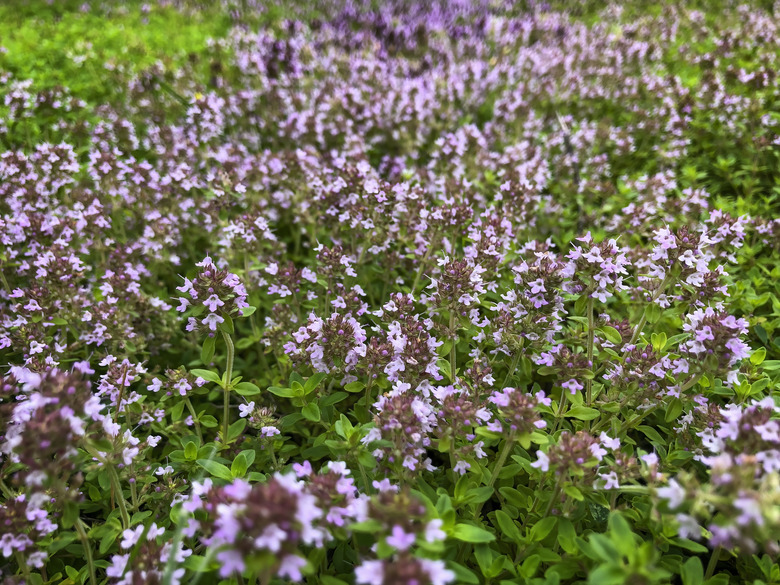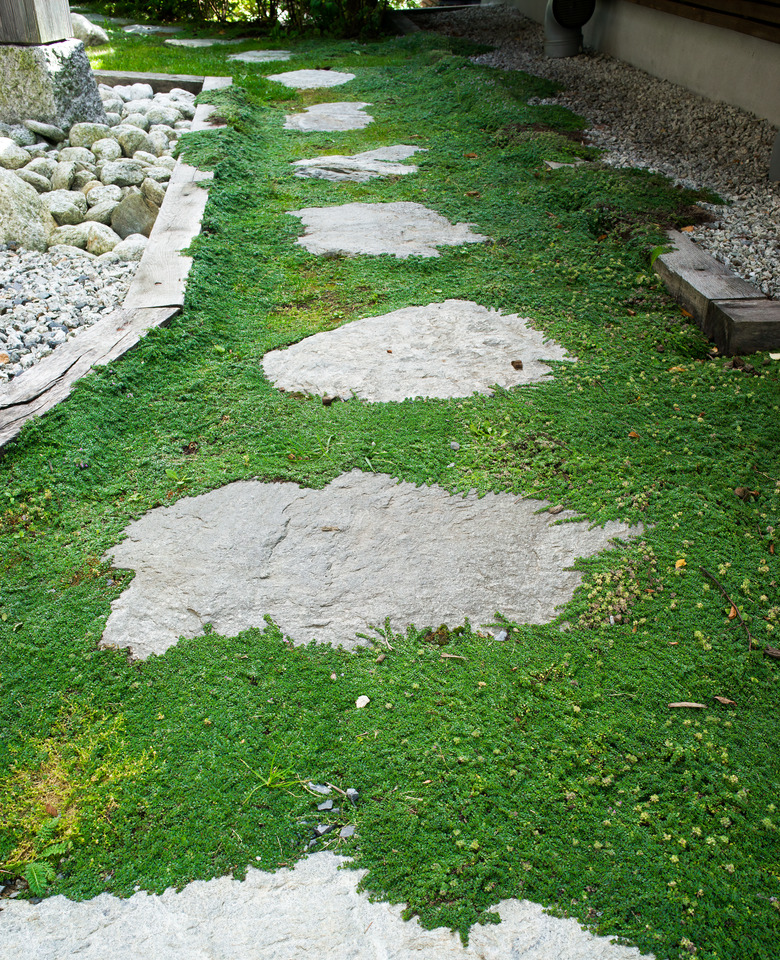Creeping Thyme Lawn: How To Grow Your Own (And Why You Should)
We may receive a commission on purchases made from links.
A creeping thyme lawn can make an excellent alternative to traditional turf if you can provide it with the right growing conditions. This plant requires plenty of sun and well-draining soil. Some varieties — not all — can hold up to foot traffic. Creeping thyme provides beautiful ground cover adorned with flowers in various colors, with minimal watering and maintenance necessary. We spoke with gardening expert Tony O'Neill about the benefits and drawbacks of creeping thyme and how to grow it in your own yard.
What Is Creeping Thyme?
What Is Creeping Thyme?
As you may have guessed, creeping thyme comes from the same genus as the thyme herb found in kitchens around the world. Many species and cultivars release a pleasant citrusy/minty smell when walked on. You can even use some species and cultivars of creeping thyme to spice up your soups, stews, and meats in the kitchen, although not all types are suitable for culinary use. "In addition to its culinary and ornamental uses, creeping thyme has a long history of medicinal use," notes O'Neill. "It has been traditionally employed for its antiseptic properties and as a natural remedy for coughs, respiratory ailments, and digestive issues. Creeping thyme offers beauty, fragrance, and potential health benefits."
Tip
Common thyme (Thymus vulgaris) thrives in the same conditions as creeping thyme, so you can grow thyme for cooking in an adjacent area to your creeping thyme.
Grass vs. Creeping Thyme Lawn
Grass vs. Creeping Thyme Lawn
Grass Lawn
- Needs to be mowed, particularly in the summer months
- Not beneficial for pollinators
- Has a tidy, traditional appearance
- High water, fertilizer, and maintenance needs
Creeping Thyme Lawn
- Less maintenance than a traditional lawn
- Doesn't need to be mowed
- Lower water and fertilizer needs
- Has a fragrant aroma
- Attracts pollinators
"Creeping thyme is an outstanding ground cover option due to its ability to suppress weeds, low-maintenance requirements, and visually appealing matlike growth habit," says O'Neill. If you're not dead set on a classic turf lawn, creeping thyme ground cover is an attractive alternative. "Compared to grass, creeping thyme requires less maintenance, such as mowing, and has lower water and fertilizer needs," O'Neill explains. "It also adds a fragrant aroma and attracts pollinators to the garden."
O'Neill says a significant benefit of creeping thyme is that it does not "need to be mowed, as its low-growing habit eliminates the need for regular trimming." Some homeowners still choose to mow their creeping thyme ground cover after the blossoms fade to keep it looking tidier. It's best to avoid mowing a creeping thyme lawn in bloom, as the flowers add beautiful colors to your yard while supporting pollinators, like butterflies and bees. Not mowing also keeps the plant thicker and denser, which helps suppress weed growth, though O'Neill notes that "occasional weeding may be necessary to maintain its pristine appearance."
A creeping thyme lawn works so well as a grass alternative partly because it thrives in similar conditions to most turfgrass and will grow right up to hardscaping, like paths, patios, sidewalks, and roads. It's also a great option for planting around stones in a flagstone path or in driveway gardens.
The Best Creeping Thyme Varieties for Landscaping
The Best Creeping Thyme Varieties for Landscaping
With many cultivars available, creeping thyme colors include leaves in deep green, bluish-green, silvery green, or yellow and blooms of light pink, magenta, purple, red, and white. The most common varieties sold for landscaping include:
- Red creeping thyme: The most popular
variety for ground cover, red creeping thyme (Thymus praecox 'Coccineus') has dark green leaves and deep-pink to rose-red flowers. It grows 3 to 6 inches tall and typically grows 12 wide. - Wooly thyme: A perfect lawn alternative,
wooly thyme (Thymus pseudolanuginosos) has a moderate growth rate and tolerates more foot traffic than other species. It
is easily identifiable through its gray-green fuzzy leaves and pale pink
flowers. This is one creeping thyme species that doesn't have fragrant flowers and is not suitable for culinary use. - Elfin thyme: While not the best option
for an entire lawn, Elfin thyme (Thymus serpyllum 'Elfin') is a small, slow-growing species that's a good choice for areas
where other creeping thyme cultivars may grow too large. It is commonly placed
between pavers, beside walkways, or near edging. It has small gray to silver-green
leaves and lavender-pink flowers. - Pink chintz: A drought-tolerant dwarf
cultivar, pink chintz (Thymus serpyllum 'Pink Chintz') has salmon-pink flowers and blue-green leaves. It
grows 2 to 3 inches tall with a 12- to 18-inch spread.
To make your yard really striking, plant a few species in order to enjoy creeping thyme in multiple colors. Growing multiple varieties adds visual interest to your yard and helps extend the flowers' blooming season.
Tip
Creeping thyme would also make a stunning addition to a "driveway garden" to break up the monotony of the concrete.
How Much Does Creeping Thyme Cost?
How Much Does Creeping Thyme Cost?
While it's easy to find creeping thyme at local nurseries, garden centers, and online retailers, the price can be prohibitive. "Prices may vary depending on the region and specific variety," says O'Neill, "but generally, it can cost anywhere from $50 to $200 to establish a 100-square-foot creeping thyme lawn." While creeping thyme seeds are less expensive than small seedlings, referred to as plugs, springing for the pricier option is usually better, as it grows very slowly from seed.
In What Zones Does Creeping Thyme Grow Best?
In What Zones Does Creeping Thyme Grow Best?
While creeping thyme is a perennial, it will survive year to year only when grown in the right climate (as is the case when growing common thyme). "Creeping thyme thrives in various climates but tends to do best in regions with moderate temperatures and well-draining soil," says O'Neill. Most types prosper in USDA plant hardiness zones 4 through 8, although some species and culivars also do well in zones 9 and 10.
Soil, Sunlight, and Water Recommendations
Soil, Sunlight, and Water Recommendations
Like all plants, creeping thyme does best under the right growing conditions. "Creeping thyme thrives in well-draining soil with a slightly alkaline to neutral pH," says O'Neill. "Amending the soil with organic matter can improve its growing conditions."
As for light exposure, creeping thyme prefers full sun, but it can survive in light shade. If it gets less than six hours of sun a day, though, it tends to become a little leggy with more stems and too little foliage, which isn't ideal for a ground cover.
"Creeping thyme requires more water initially to establish its root system but becomes drought-tolerant once it has settled in," says O'Neill. It usually takes about one season for the plant to become fully established and grow at full speed, at which time you can cut back on watering in all but the driest summer conditions. While fertilizer isn't mandatory with these low-maintenance plants, O'Neill says "a light application of balanced fertilizer in the spring can promote healthy growth."
Things Needed
-
Broad-spectrum herbicide (optional)
-
Shovel (optional)
-
Black plastic film (optional)
-
Newspaper or cardboard (optional)
-
Rocks, pavers, or bricks (optional)
-
Mulch
(optional) -
Seed trays (optional)
How to Plant a Creeping Thyme Lawn
How to Plant a Creeping Thyme Lawn
"The best time to plant creeping thyme [plugs] is typically in the spring or fall, avoiding extreme temperatures and frost," says O'Neill. But when you want to plant creeping thyme, you need to start early because it's not just a matter of sprinkling seeds across your yard. The process can be long and tedious, so if you're asking "can I plant creeping thyme in the fall?" you may need to start preparing your yard a whole year in advance. Because it is so expensive and time-consuming to establish a creeping thyme lawn, it's usually better to work in small sections rather than converting your entire lawn at once (unless you have a tiny yard to start with).
1. Remove Your Lawn (as needed)
If you're replacing existing turf grass with creeping thyme, the first step is to kill the grass and remove it. If you don't have a lawn, you can skip this step, and the process will go much more quickly. There are multiple ways to eradicate your grass, including:
- Spraying the whole thing with a broad-spectrum
herbicide, like Roundup, though this is not the most eco-friendly option, as
these sprays can damage entire ecosystems. This method is the fastest, as it allows
you to start growing your creeping thyme in as little as three days, depending
on the product you use. - Digging up the grass. This option requires a lot
of work, and you must dig deep to remove all roots, or more grass may just
sprout up in its place. - Using a sod cutter to cut the turf into sections before removing it.
- Smothering the grass with newspaper or cardboard and
then covering it with mulch. Water the mulch well and push the paper down
against the grass to speed up the process. You may further weight down the papers with rocks, pavers, or bricks. The following year, the grass will be dead, and much
of the newspaper or cardboard will have decomposed. You can poke holes through
any remaining newspaper or cardboard to plant thyme plugs and leave the rest
of the paper material in place to operate as a weed barrier as your thyme
becomes established.
2. Prepare the Soil
Till the soil to a depth of about 6 inches, and add any needed nutrients to the soil (as indicated by the results of a soil test) by working in compost, blood meal, or rock phosphate. Be sure to pull out any remaining grass roots you find after you dig up the soil.
3. Plant the Creeping Thyme
Creeping thyme can be grown with seeds or plugs. Different species have different propagating recommendations; for example, Thymus serpyllum most commonly is started from seed. You can sow seeds outdoors or use them to grow your plugs in starter trays indoors. When you sow creeping thyme seeds, be patient, as it takes up to 28 days to germinate.
To start creeping thyme seeds outdoors:
- Plant in March, April, or May when any threat of frost has passed. Do not sow creeping thyme
seeds outdoors in the fall or the emerging plants can suffer frost damage. - Scatter seeds
on the soil, then lightly press them into the soil; do not cover the seeds,
as they need light to grow. - Keep the soil consistently moist until the majority
of seeds have germinated, then switch to watering whenever the top few inches of soil feel
dry. You may add a thin layer of mulch around the plants to discourage weed growth and maintain
moisture. - When the plants reach a few inches tall, thin them to between 12 and 24 inches
apart.
To sow creeping thyme seeds indoors:
- Sow seeds six to
eight weeks before the last frost in your area. - Fill starter trays with loose, well-draining potting mix that doesn't contain fertilizer (which can burn emerging seedlings) or coir.
- Place two or three seeds on the top of the
soil in each tray. - Keep trays near the window so they can stay warm and get
plenty of indirect light. - Keep the soil in the seed trays moist.
- Once well established
and 2 to 3 inches tall, you can transplant the plugs outside after hardening
them off for a week or two by placing them outdoors during the day in a partial-shade location and indoors at
night.
To plant creeping thyme plugs:
- Dig a hole
the width and depth of the plug, place the seedling in the hole, and push down the
soil around it. - Space creeping thyme plugs about 18 to 24 inches apart to
prevent the plants from getting overcrowded, which will cause them to become too
leggy.
Pros of a Creeping Thyme Lawn
- Creeping thyme is easy to care for. It needs
minimal water and fertilizer and does not need to be mowed. - It's good for the earth. "Creeping thyme
is considered eco-friendly, as it requires less water [than turf grass], reduces the need for
chemicals and herbicides, prevents soil erosion, and provides a habitat for
beneficial insects," says O'Neill. - The plants suppress weeds. Once they become esablished, creeping thyme plants grow in thickly, choking out weeds.
- The flowers support pollinators. Creeping
thyme flowers come in multiple attractive colors, like red, pink, and purple, and they
provide nectar and pollen for bees, butterflies, and other pollinators. - It smells amazing. Creeping thyme has a wonderful
minty, citrusy scent and can even be used as an herb in the kitchen. - The scent repels pests. Creeping thyme can
help keep deer, rabbits, and mosquitoes out of your yard.
Cons of a Creeping Thyme Lawn
- Creeping thyme takes a while to establish.
"Slow growth can require patience," says O'Neill, and "an initial establishment
may take time." - Seeds and plugs are pricey. It can cost a
lot to get a whole yard started. - Eliminating grass is difficult. Whether
labor-intensive and/or time-consuming, removing your existing grass lawn can be
challenging.
Creeping Thyme FAQs
Creeping Thyme FAQs
Will creeping thyme take over grass?
"If not properly contained, creeping thyme may outcompete grass and spread into areas where the grass is desired," explains O'Neill. However, "installing edging or barriers can help prevent its spread."
How quickly does creeping thyme spread?
While the plants spread effectively, don't let the name "creeping" fool you into thinking they grow quickly. "Creeping thyme has a slow growth rate, taking some time to reach its full size, but it eventually forms a dense ground cover," says O'Neill.
Is creeping thyme OK to walk on?
Yes. "Creeping thyme can tolerate light foot traffic, making it suitable for pathways and areas where occasional walking is required," explains O'Neill. "However, it may not withstand heavy or constant foot traffic." If you know you'll be crossing the lawn a lot, install a flagstone path or choose a more sturdy variety, like wooly thyme.
What happens to creeping thyme in winter?
"Creeping thyme is a perennial herb that regrows and persists year after year," says O'Neill. During winter, most types stay evergreen as long as plants are not subjected to freezing temperatures that are beyond the coldest zone for a specific species or cultivar's hardiness limit.



